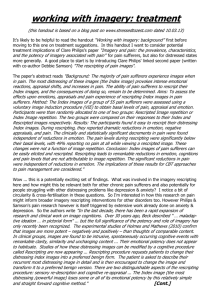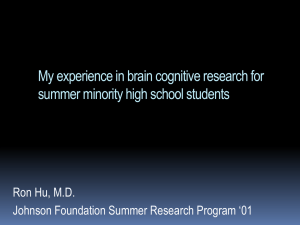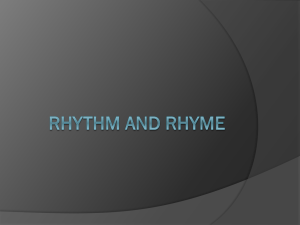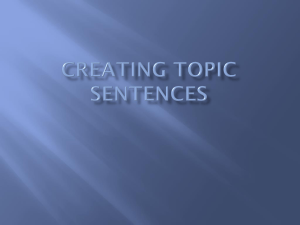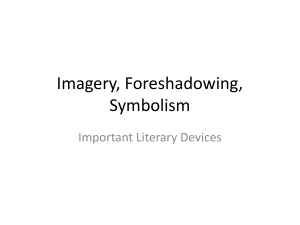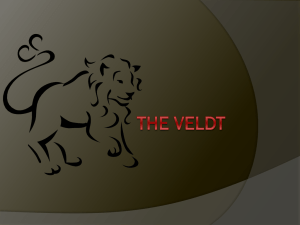Imagery Rescripting and Reprocessing Therapy Presented by
advertisement
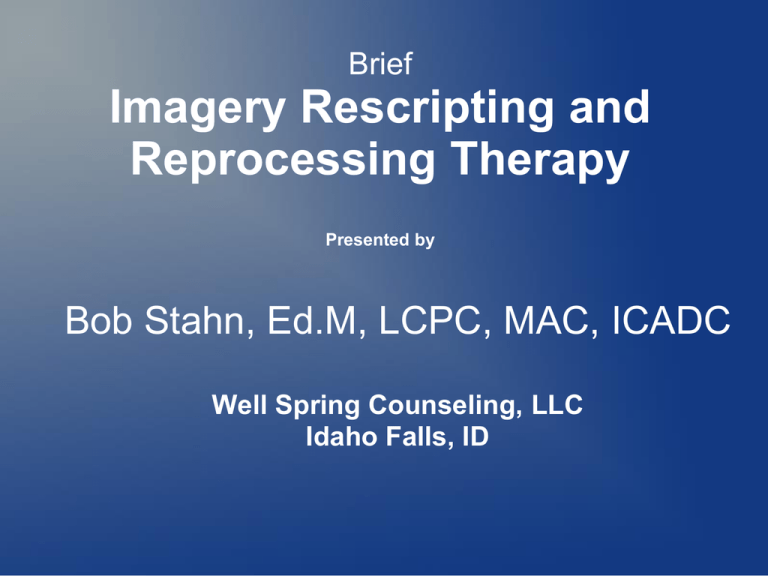
Brief Imagery Rescripting and Reprocessing Therapy Presented by Bob Stahn, Ed.M, LCPC, MAC, ICADC Well Spring Counseling, LLC Idaho Falls, ID Brief Imagery Rescripting and Reprocessing Therapy (BIRRT) One in five people who experience trauma will develop PTSD Brief Imagery Rescripting and Reprocessing Therapy (BIRRT) CBT works most effectively on PTSD Historically, CBT is effective up to 60% If the emotion is predominantly fear based, then exposure therapy may be up to 90% effective Exposure therapy often takes10-12 90-minute sessions Brief Imagery Rescripting and Reprocessing Therapy (BIRRT) In 1990 Aaron Beck Stated: “Simply talking about a traumatic event may give intellectual insight about why the patient has a negative self-image, but it does not actually change the image....” Brief Imagery Rescripting and Reprocessing Therapy (BIRRT) Beck continued: “In order to modify the image, it is necessary to go back in time, as it were, and recreate the situation. When the interactions are brought to life, the misconstruction is activated—along with the affect—and cognitive restructuring can occur.” Brief Imagery Rescripting and Reprocessing Therapy (BIRRT) In 1990 Mervin Smucker, Ph.D, from the Medical College of Wisconsin, created Imagery Rescripting and Reprocessing Therapy (IRRT) for the processing of traumatic experiences. Brief Imagery Rescripting and Reprocessing Therapy (BIRRT) Dr. Smucker found excellent success with IRRT (in approximately 10 sessions). Especially with Type I (single incident, acute life threat and unexpected) But found less success with Type II (repeated, prolonged and unpredictable course) Brief Imagery Rescripting and Reprocessing Therapy (BIRRT) Dr. Smucker's Therapeutic Goals of IRRT: Decrease physiological arousal Eliminate intrusive PTSD symptoms Transform traumatic imagery into mastery, self-empowering imagery Modify trauma-related beliefs/schemas Enhance ability to self-calm, self-nurture and affectively self-regulate Enhance linguistic processing by developing a narrative about the traumatic event Brief Imagery Rescripting and Reprocessing Therapy (BIRRT) Dr. Smuckers' Inclusion Criteria Recalls or re-experiences at least one traumatic memory (nightmares, flashbacks) Most or all of the traumatic memory is visualized (and re-experienced) along with the painful affect Non-fear emotions (e.g., guilt, shame, self blame) are predominant Brief Imagery Rescripting and Reprocessing Therapy (BIRRT) Dr. Smuckers' Exclusion Criteria Client currently has: Involvement in an abusive relationship Alcohol/Substance Abuse or on heavy meds Dx of Acute psychosis, Dissociative Identity Disorder, Schizophrenia or Severe Depression Overwhelming/traumatic daily stressors Vague/incomplete traumatic memories Absence of visual trauma images Brief Imagery Rescripting and Reprocessing Therapy (BIRRT) 3 Steps of Dr. Smucker's IRRT Imagery: Step 1—Imaginal Exposure (re-experience the truamatic episode) Step 2—Mastery Imagery (episode starts the same but onto it is spliced the perfect ending) Step 3—Adult-Child Imagery (nurturing, comforting and educating the person who experienced the traumatic episode) Brief Imagery Rescripting and Reprocessing Therapy (BIRRT) Comparing IRRT and BIRRT Same principles Same results But BIRRT is... well... brief! Brief Imagery Rescripting and Reprocessing Therapy (BIRRT) The Good News The technique is brief to administer. It generally is done in one two-hour session per event. BIRRT is very effective. BIRRT breaks the trauma weld between the emotions and the details of the traumatic event. There is no hypnosis, touching, specific eye movement or holding of objects with BIRRT. Brief Imagery Rescripting and Reprocessing Therapy (BIRRT) The Good News (cont.) The technique uses imagery only. The results are immediate. Nearly all clients report a feeling of relief, peace and relaxation. The results are enduring. PTSD symptoms are greatly reduced or eliminated. Brief Imagery Rescripting and Reprocessing Therapy (BIRRT) The Bad News: BIRRT is event specific. Each dissimilar traumatic event must be dealt with an individual 2-hour session. BIRRT is not supportive therapy. The process is not easy. It requires substantial trust by the client in the therapist, in the process and in the client's own strengths. Brief Imagery Rescripting and Reprocessing Therapy (BIRRT) The Bad News (cont.) There is homework. It includes rehearsing the “new ending” and spending time nurturing the younger client— twice a day for a week. All told, the BIRRT process is not easy but it is very much worth the effort. Generally clients are not eager to GO through the BIRRT process, but are eager to BE through the process. Brief Imagery Rescripting and Reprocessing Therapy (BIRRT) THE STEPS Preparation for Step 1: Summarize the process for the client Establish a Pre-BIRRT severity level (i.e., PTSD 30) Have client briefly outline the traumatic event Together determine who will be introduced into the imagery during Step 2 Brief client on checking 1-100 level of discomfort Brief Imagery Rescripting and Reprocessing Therapy (BIRRT) THE STEPS Preparation for Step 1 (cont): Encourage client to keep the recounting of the event relatively short (latest in, earliest out) Describe event in first person, present tense Encourage client to push through all of Step 1 without giving up Client may invite a support person into session Reassure client about the likely outcome Brief Imagery Rescripting and Reprocessing Therapy (BIRRT) THE STEPS Step 1: Client is invited to close eyes. Envisions & describes the traumatic event, often via each of five senses After every few sentences spoken by the client, the therapist summarizes Frequently check 1-100 level of discomfort Spend whatever time needed on any point in the event to bring the client emotionally into the event Brief Imagery Rescripting and Reprocessing Therapy (BIRRT) THE STEPS Step 1 (cont.): End by asking if there is anything else the client would like to include in this imagery Invite client to open eyes and return to the present After Step 1 is completed, congratulate the client on a difficult job successfully done Again reassure client about likely outcome Brief Imagery Rescripting and Reprocessing Therapy (BIRRT) THE STEPS Step 2: Start the event again, just as in Step 1 Encourage the client to use all senses in describing the event in order to be present in it Before the high point of discomfort, begin the new ending Brief Imagery Rescripting and Reprocessing Therapy (BIRRT) THE STEPS Step 2 (cont): The new ending consists of introduction of people who will 1) empower and protect client 2) prevent trauma from happening 3) hold abuser, if any, accountable The people may be anyone--real or fictional, historical, religious, superheroes or even the present-day client. Often includes law enforcement. Each is omniscient. Brief Imagery Rescripting and Reprocessing Therapy (BIRRT) THE STEPS Step 2 (cont): Have intervening people also teach the client the truth about: the client's value who is responsible for causing the trauma anything else that is true and pertinent End Step 2 by asking if there is anything else the client would like to include in this imagery Invite the client to open his/her eyes Brief Imagery Rescripting and Reprocessing Therapy (BIRRT) THE STEPS Step 3: Have client close eyes and envision a “happy place,” describing it via each of the five senses Invite client to picture the younger self (of the traumatic event just reprocessed) Ask client to also envision the self of today with the younger self Brief Imagery Rescripting and Reprocessing Therapy (BIRRT) THE STEPS Step 3 (cont): Help today's client to nurture, encourage, comfort and teach by speaking directly to the younger client Invite today's client to commit to help, protect and be a companion to the younger client Allow the younger client to respond and ask questions or make requests to meet needs Brief Imagery Rescripting and Reprocessing Therapy (BIRRT) THE STEPS Step 3 (cont): Continue until the younger client feels nurtured, comforted and guilt-free If done well, the younger client will feel grateful. Encourage him/her to express gratitude (usually by physical contact, such as a hug) and allow the client of today to reciprocate Close Step 3 when neither has more to say/do Brief Imagery Rescripting and Reprocessing Therapy (BIRRT) THE STEPS After Step 3: Invite the client to express how he/she feels about the results of the process Remind client of the likely outcome of the process Assign the homework of reviewing twice daily the new ending and nurturing the younger client and call with a report the next day At some point in the future (month, etc) again assess the PTSD symptom severity (i.e., PTSD 30) Brief Imagery Rescripting and Reprocessing Therapy (BIRRT) The Results The Measuring Tool—The PTSD 30 - A 30-item questionnaire - Based on DSM-IV Diagnostic Criteria - A six-point severity scale (0=low, 5=high) Brief Imagery Rescripting and Reprocessing Therapy (BIRRT) PTSD 30 Items You have distressing dreams (nightmares). You do not feel like being around anyone. You feel as though you experience the trauma again (flashbacks). You feel like you are not in control. You go over the trauma again and again in your head. You jump more than others when you get startled. You do not remember parts of the traumatic event. You make strong efforts to avoid things connected to the trauma. You avoid thoughts, feelings and conversation connected to the trauma. You feel numb or have very few emotions. Brief Imagery Rescripting and Reprocessing Therapy (BIRRT) You feel less interested or participate less in previously enjoyed activities. You feel like you have no future or that it’s hard to plan a future. You often feel anxious. You have difficulty staying or falling asleep. You get scared easily. You feel scared when reminded of the trauma. You feel irritable. You have outbursts of anger. You have difficulty focusing, concentrating, or completing tasks. Brief Imagery Rescripting and Reprocessing Therapy (BIRRT) You have urges to hurt yourself. You act out all of a sudden without thinking, are impulsive. You feel shame and guilt because you are partially responsible for the trauma. You feel hopeless and in despair. You feel permanently damaged. You feel hostile. You feel constantly on guard because you feel threatened. You have a change in personality because of the trauma. Your heart races and you sweat when reminded of the trauma. You do not feel connected with others. You are overly aware of everything around you. Brief Imagery Rescripting and Reprocessing Therapy (BIRRT) The Results The Population - 57 Adult men and women who sought PTSD treatment at Well Spring Counseling - They met PTSD criteria - Information was collected starting AUG ‘11 Brief Imagery Rescripting and Reprocessing Therapy (BIRRT) The Results The Process - Pre-BIRRT measure taken (PTSD 30) - BIRRT administered until all traumatic events were addressed - At some point (weeks to years) a Post-BIRRT measure was taken Brief Imagery Rescripting and Reprocessing Therapy (BIRRT) The Results - Average Pre-BIRRT score 3.7 (on 0-5 scale) - Average Post-BIRRT score 0.87 (no longer meet PTSD criteria)! - Average benefit--nearly 3 points! Brief Imagery Rescripting and Reprocessing Therapy (BIRRT) Brief Imagery Rescripting and Reprocessing Therapy (BIRRT) BIRRT Client Comments “As a Vietnam veteran I had nightmares 2-3 times weekly and frequent flashbacks for over 40 years….One visit with Bob, however, and [the symptoms] were all gone for good. My depression is better. I felt more relaxed than I had in 40 years! Bob helped me more in one session than everything else I have done. I was skeptical before but a firm believer after.” -Gordon Brief Imagery Rescripting and Reprocessing Therapy (BIRRT) BIRRT Client Comments “I’m very different than I was a year ago…. The rescripting got out a tremendous amount of darkness. I don’t explode as I used to. I see life from a different perspective. I feel a lot of peace. It’s wonderful!” -Lisa "I’m more relaxed….I’m much more hopeful than in the past. I have a more positive outlook at life. I’m very impressed with the effectiveness of the technique.” -Casey (Veteran) Brief Imagery Rescripting and Reprocessing Therapy (BIRRT) “A weight or block that’s always been there is now gone! It’s amazing to me…. I don’t feel responsible even though I didn’t realize I was feeling that way before. I have carried anger for years but didn’t realize it. It’s night and day difference…. It is surprising where I am today.” -Teresa “I’m happier and I feel more relaxed and good. It’s cool! I feel more confident; more peaceful. It’s almost like a memory now—a sense of serenity that I never knew I could have.” -Katie Brief Imagery Rescripting and Reprocessing Therapy (BIRRT) “I met with Bob just once, but it made a world of difference—definitely great improvement…. I’m surely grateful. I highly recommend Bob and [Brief] IRRT!” -Pat “The knot in middle of stomach is gone. I feel relieved and lighter…. I feel more freedom. I don’t feel the guilt and shame. It’s gone. I wasn’t sure this process was going to work but it did. It was excellent…. I haven’t wanted to use anymore…. I’m not afraid anymore after years of being afraid. I don’t feel powerless (especially about men) anymore…. BIRRT was absolutely worth it.” -Sandy Brief Imagery Rescripting and Reprocessing Therapy (BIRRT) “I feel more relaxed than I’ve ever been! I can hardly stand this. I feel like I’m on a retreat and I never have to leave! This is just incredible! ….I now feel joy coming from within and it’s increasing. I’m feeling a lot of peace and happiness on a regular basis.” –Jo “It’s completely different [since Brief IRRT]. Before I’d be curled up on the floor but now I’m dealing with it. It’s amazing!” -Billie Brief Imagery Rescripting and Reprocessing Therapy (BIRRT) “I feel very happy--much better than I have in a long time….I can be myself without barriers! …Where I was and where I am now is night and day difference and I attribute it to [Brief] IRRT and to taking care of myself…I’m down to one medication from seven! And that one is going pretty soon. I’m more positive and not so depressed…. I am so very grateful.” -D'Arcy “Life is quite joyful. I’m doing fantastic. [BIRRT] was very effective for me--extremely, extremely beneficial for me. I wish I’d known about this decades earlier.” -Kathy Brief Imagery Rescripting and Reprocessing Therapy (BIRRT) “Wow! I feel better. I feel relief. I feel confident. I’m less anxious. Wow! This is the most confident I’ve felt in probably 10 years. I didn’t think this would work but wow! …Feeling this is really amazing. I haven’t felt this peaceful since I was a child. Wow! Thank you!” -T.M. “After nearly two years I am still symptom free. I had no idea this kind of help was available. I have been through a lot of counseling before and had not found anything this beneficial.” -Kathy Brief Imagery Rescripting and Reprocessing Therapy (BIRRT) “I’m freed from the [traumatic] moment. I’m shocked at the outcome…. Before doing it I thought ‘It ain’t going to work!’ But it did. I feel great…. Just one IRRT session--I didn’t think it would work but it did. All my symptoms are gone except a small amount of anxiety. I’m surprised it worked so well. I’m doing really good.” -Patricia Brief Imagery Rescripting and Reprocessing Therapy (BIRRT) THE RESULTS Interesting phenomenon at Post-BIRRT scoring Client comments Brief Imagery Rescripting and Reprocessing Therapy (BIRRT) Questions and Answers

